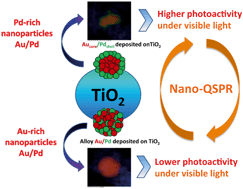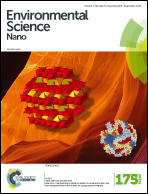Combined experimental and computational approach to developing efficient photocatalysts based on Au/Pd–TiO2 nanoparticles†
Abstract
Surface modified TiO2-based nanoparticles (the so-called second generation nanoparticles) have unique semiconducting properties. They act as efficient photocatalysts, demonstrating catalytic activity under UV-vis and light-emitting diode (mix-LED) light. Consequently, they can be used as versatile, low-cost, clean and environmentally benign components in many innovative solutions, e.g. treatment technology for a wide range of environmental pollutants. However, for commercial application of TiO2-based systems, it is crucial to develop nano-powders that can absorb light in the visible spectrum. Our investigation has demonstrated the potential benefits of using a chemoinformatics approach to obtaining knowledge on structural features responsible for the photocatalytic activity of second generation NPs under visible light. Through a combination of multiple linear regression (MLR) and a genetic algorithm (GA), we have developed a quantitative structure–properties relationship (Nano-QSPR) model (R2 = 0.89, RMSEC = 1.67, QLOO2 = 0.82, RMSECV = 2.18, QEXT2= 0.80, RMSEP = 1.46) based on the most relevant physicochemical properties that characterized selected Au/Pd–TiO2 NPs. According to the developed Nano-QSPR model, the anatase phase and palladium content are the main factors responsible for the higher activity of Au/Pd–TiO2 photocatalysts under visible light. It should be noted that the methodology presented here can serve as an important starting point for further design of new nanomaterials with enhanced functionality, supported by chemoinformatics methods.



 Please wait while we load your content...
Please wait while we load your content...